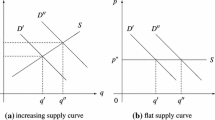Abstract
In a simple economy (a produced good and labour), a discrete‐time tatonnement processconverges only at low rates of adjustment and shows cycles and chaotic behaviour at higherrates, where prices in turn go up and down. The same holds for a sequence of fixed priceequilibria, with price adjustment directed by effective excess demands. We look at the casewhere two markets open consecutively, the labour market first. Labour demand, productionand goods supply are determined by expectations, depending on the demand of the previousperiod. This again leads to cycles and chaos, but also to long periods of ascent and decline.
Similar content being viewed by others
References
V. Bela and M. Majumdar, Chaotic tatonnement, Economic Theory 2(1992)437-445.
J.P. Benassy, Neo-Keynesian disequilibrium in a monetary economy, Review of Economic Studies 42(1975)503-523.
V. Böhm, Disequilibrium dynamics in a simple macro-economic model, Journal of Economic Theory 17(1973)177-199.
V. Böhm, Recurrence in Keynesian macroeconomic models, DP 436/90, University of Mannheim, 1990.
R.H. Day and G. Pianigiani, Journal of Economic Behavior and Organization 16(1991) 37-83.
J.H. Drèze, Existence of exchange equilibrium under price rigidities, International Economic Review 16(1975)301-320.
S. Honkapohja and T. Ito, Stability with regime switching, Journal of Economic Theory 29(1982)22-48.
E. Malinvaud, The Theory of Unemployment Reconsidered, Basil Blackwell, Oxford, 1977.
D.G. Saari, Iterative price mechanisms, Econometrica 53(1985)1117-1131.
P. Van den Heuvel, The Stability of a Macro-economic System with Quantity Constraints, Lecture Notes in Economics and Mathematical Systems, Springer, Berlin, 1983.
E.C.H. Veendorp, Stable spillovers among substitutes, Review of Economic Studies 42 (1975)445-455.
C. Weddepohl, Erratic dynamics in a restricted tatonnement process with two and three goods, in: Predictability and Nonlinear Modelling in Natural Sciences and Economics, eds. J. Grasman and G. van Straten, Kluwer, Dordrecht, 1994, pp. 609-620.
C. Weddepohl, Simulating disequilibrium dynamics in a production economy, A.E. Report, 15/1994.
C. Weddepohl, A cautious price adjustment mechanism: Chaotic behavior, Journal of Economic Behavior and Organization 27(1995)293-300.
C. Weddepohl, A simulation study of disequilibrium price dynamics, in: Dynamic Disequilibrium Modelling, eds. W.A. Barnett, G. Gandolfo and C. Hillinger, Cambridge University Press, Cambridge, 1996, chap. 15, pp. 421-443.
Rights and permissions
About this article
Cite this article
Weddepohl, C. Price adjustment models in a production economy. Annals of Operations Research 89, 149–164 (1999). https://doi.org/10.1023/A:1018967405289
Issue Date:
DOI: https://doi.org/10.1023/A:1018967405289




